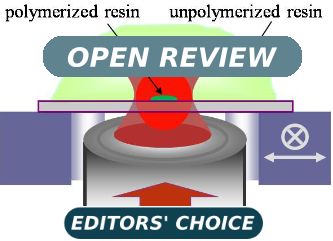Surface Percolation and Growth. An alternative scheme for breaking the diffraction limit in optical patterning
DOI:
https://doi.org/10.4279/pip.010008Keywords:
Lithography, Polymerization, PatteriningAbstract
A nanopatterning scheme is presented by which the structure height can be controlled in the tens of nanometers range and the lateral resolution is a factor at least three times better than the point spread function of the writing beam. The method relies on the initiation of the polymerization mediated by a very inefficient energy transfer from a fluorescent dye molecule after single photon absorption. The mechanism has the following distinctive steps: the dye adsorbs on the substrate surface with a higher concentration than in the bulk, upon illumination it triggers the polymerization, then isolated islands develop and merge into a uniform structure (percolation), which subsequently grows until the illumination is interrupted. This percolation mechanism has a threshold that introduces the needed nonlinearity for the fabrication of structures beyond the diffraction limit.
Received: 9 November 2009, Accepted: 29 December 2009; Edited by: J. J. Niemela; Reviewed by: H. Cabrera Morales, Inst. Venezolano Invest. Científicas, Venezuela; DOI: 10.4279/PIP.010008

Downloads
Published
How to Cite
Issue
Section
License
Copyright (c) 2010 D. Kunik, L. I. Pietrasanta, O. E. Martínez

This work is licensed under a Creative Commons Attribution 4.0 International License.
Authors agree to the PIP Copyleft Notice













